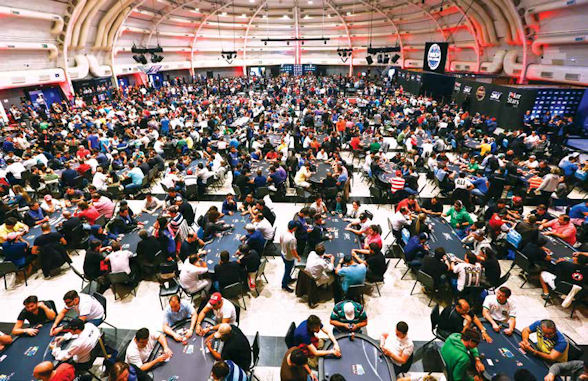This article first appeared in the Jan/Feb 2016 issue of WGM.
WGM takes an in-depth look at pre-flop open bet sizing in tournament poker and how this important aspect of the game has evolved in recent years.
Poker is a game that is always evolving – so much so that even the most routine decisions are constantly analyzed and adjusted to better suit the modern game.

Among these is the seemingly simple concept of bet sizing.
Bet sizing, like anything, becomes increasingly complex as a hand progresses – particularly when deep in a multi-table tournament (MTT) situation when one wrong move can cost you your stack. But it all starts pre-flop, so in this article we’re going to focus on bet sizing as it applies to opening pre-flop.
For as long as tournament poker has graced the earth – and certainly since No Limit Hold’em became the dominant discipline – the accepted standard open size has been to three times the big blind (referred to as 3x). Although some players have preferred to vary it slightly to 3.5 or even 4x, the standard 3x has typically been seen as a happy medium in regards to risk/reward when stacks are deep – not too large as to scare everyone out but big enough to discourage opponents calling with almost any two cards.
This tended to be accepted practice whether opening Under The Gun (UTG) or stealing from the button and it’s reasonable to suggest that many players did so without giving it a second thought.
The 3x open is still a popular one today although good players do so with more purpose – whether they are opening AA or 78 suited, the bet size doesn’t change so as to hide the strength or weakness of their hand.
The question then simply boils down to the range of hands each individual player is willing to play.

As one of Australia’s most accomplished tournament players, Grant Levy, explained to us, “My open size early in tournaments is usually 2.5x to 3x and stays standard throughout the entire early stage. It usually doesn’t vary at all based on position.
“I’m happy to play multi-way pots early in tournaments. You’re never really going to stack someone a couple of hundred big blinds deep, so if people want to play pots I’m happy to oblige and try and flop some big hands.
“This usually brings into play suited connector type hands and suited one-gappers plus all pairs (looking to flop a set).”
The one caveat to keeping it standard is the need to be situationally aware, because there will inevitably be times when adjusting your open size is clearly the optimal play.
“I try to open for the same early in tourneys no matter what I have and in any position so I don’t have sizing tells, but here in Los Angeles they love to see flops and won’t fold no matter how big the raise,” says American tournament pro and friend of WGM Phong “Turbo” Nguyen. “So it’s situational. If I happen to be on a table full of guys willing to call a big raise then I will happily make it bigger and try and isolate.”
Clearly players are putting much more thought into each and every action these days than they did during the early days of the poker boom in the early to mid-2000s, but all in all any adjustments they’ve made during the early stages are mostly cosmetic.

Not so the middle stages when antes kick in and effective stacks get shallower against the rising blinds. This is where modern players actively begin adjusting their open sizes down, with open sizes generally trending anywhere between 2x to 2.5x as a rough guide.
For those keen to see this change visualized, the quickest way is to watch a few tournaments or Sit’n’Gos as an observer on an online poker site. In the low stakes events, players will often continue to open 3x even when the blinds get big because they’ve never thought to do anything else. Compare that to bigger buy-in tournaments – which naturally attract a better quality of player – and you will notice smaller bet sizing is far more prevalent.
“As effective stacks get shallower, I open to anywhere from 2x to 2.4x,” continues Levy. “It’s a lot easier and really quite standard to open smaller because due to effective stacks being shallower, people are risking a higher percentage of their stack to proceed with a hand, so essentially what you are achieving with a smaller open is pretty much on par with what you’d achieve in the early stages of the tournament opening to 3x to 3.5x.”
The natural progression of this has been the min-raise once the tournament enters the latter stages.
It’s worth noting that for many years, opening to 2x was considered a recipe for disaster – the general consensus being that it reduced a player’s ability to steal pots by failing to discourage opponents from calling.
But with conserving chips just as important as accruing them, observant players soon realised that not only were they risking less with the min-raise, they didn’t have to steal the pot as often for it to be profitable.
In fact, the maths tells us that a button raise once antes are in play will only have to succeed around 40 percent of the time. By comparison, a 4x raise would need to succeed 60 percent of the time to make it profitable in the long term.

While min-raising is still considered to be a poor play in most instances – such as in cash games or early in a tournament – it specifically works in short-stacked situations … or as seven-time WSOP bracelet winner Daniel Negreanu, who is renowned for playing a small-ball style, has previously explained, “Whenever a raise represents a significant portion of your chip stack or your opponent’s.
“Often, especially in tournament poker, the size of any post-flop raise will be so substantial that it’s irrelevant whether you min-raise or toss in something more,” he said. ” That’s because your opponent will react the same way to either raise if the bet commits him or you to the pot.”
In other words, if the size of the bet makes no difference to your opponent’s decision, you may as well risk less.
It’s an intriguing example of exactly how tournament thinking has changed over the past few years … but that’s not to say these new standards are here to stay. Players are constantly looking for ways to exploit their rivals so who knows? In a few years’ time we could be witnessing a whole new range of bet sizing options infiltrating the game!







